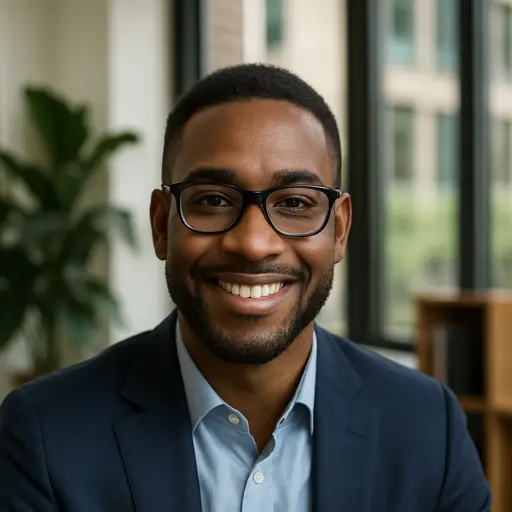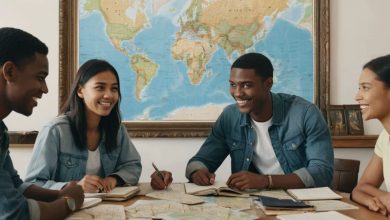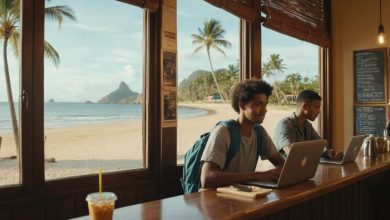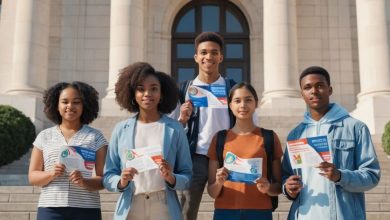Intercultural Learning Opportunities: How Exchange Programs Build Real-World Skills
Global workplaces now demand professionals who thrive in diverse settings. Exchange programs offer structured environments where students gain firsthand exposure to new cultures. These immersive experiences go beyond classroom theory, fostering skills employers value most.
Participants develop cultural awareness by navigating daily life in unfamiliar environments. They learn to communicate across language barriers and adapt to different social norms. This hands-on approach strengthens problem-solving abilities and emotional intelligence.
Educational institutions design these programs to bridge academic concepts with practical application. Through curated activities and local partnerships, students practice collaboration in multicultural teams. Such experiential formats create lasting personal and professional growth.
The results speak for themselves. Graduates often demonstrate enhanced creativity and leadership qualities valued by multinational organizations. As companies expand internationally, they increasingly seek candidates who can build connections across borders.
This guide explores how well-crafted exchange initiatives prepare learners for tomorrow’s challenges. From communication tactics to conflict resolution strategies, discover the measurable benefits of cross-cultural education.
Overview of Intercultural Learning Opportunities
Educational institutions now prioritize preparing students for cross-border collaboration. Structured initiatives like Georgia Tech’s Global Engagement Certificate transform international experiences into academic credentials. This 12-credit program connects overseas activities with classroom concepts, creating professionals ready for multicultural teams.
Understanding Global Exchange Programs
Georgia Tech’s International Plan demonstrates how universities formalize cultural exposure. Students earn a globally-focused degree designation by completing language studies, research abroad, and coursework analyzing cultural frameworks. These programs teach more than textbook theories—they foster adaptability through real-world immersion.
Building Real-World Skills through Cultural Experiences
Workshops from offices like Georgia Tech’s OIE help groups navigate cultural differences. Participants practice:
- Decoding nonverbal communication patterns
- Resolving conflicts in diverse teams
- Adapting leadership styles across cultures
Such training bridges classroom concepts with workplace demands. Graduates report improved empathy and decision-making when handling international projects. As one alumni noted: “Navigating a Tokyo lab team taught me more about collaboration than any textbook.”
The Impact of Cultural Differences on Learning
Cultural frameworks shape how people absorb information and interact in group settings. These distinctions become critical in educational environments where collaboration drives success. Understanding hidden cultural layers helps prevent misunderstandings and creates stronger team dynamics.
Recognizing Cultural Values and Perceptions
What one group views as assertive leadership might seem aggressive to another. For example:
- Direct communication styles often clash with indirect approaches
- Group-oriented societies prioritize consensus over individual decisions
- Time perception varies between strict schedules and flexible timelines
A Stanford study found teams acknowledging cultural values completed projects 23% faster. As one exchange coordinator noted: “Students who map cultural priorities adapt strategies that respect diverse perspectives.”
Bridging Communication Gaps Across Cultures
Effective collaboration requires adapting to unspoken rules. Professionals use three key tactics:
- Observing local interaction patterns before contributing
- Clarifying intentions through open-ended questions
- Adjusting feedback methods to match cultural norms
These approaches reduce friction in multicultural teams. They transform potential conflicts into opportunities for creative problem-solving.
Faculty, Staff, and Student Involvement in Exchange Programs
Three-way partnerships between faculty, staff, and students drive meaningful cultural exchanges. These groups form the backbone of successful initiatives, combining expertise to design programs that address real-world challenges. When all stakeholders engage actively, participants gain tools to thrive in diverse environments.
Collaborative Workshop Approaches
Workshops create spaces where faculty and staff guide students through practical scenarios. Through role-playing exercises and case studies, participants practice:
- Adapting communication styles for different audiences
- Resolving misunderstandings in team projects
- Building trust across cultural boundaries
Small group formats allow personalized coaching. Faculty members share academic frameworks while staff contribute logistical insights. One engineering professor noted: “Our workshops transformed how students approach international design teams—they now ask better questions upfront.”
Activities adjust based on group size and objectives. A 90-minute session might focus on decoding nonverbal cues, while semester-long programs integrate peer mentoring. This flexibility helps students apply strategies in class discussions and research collaborations.
Staff play a vital role by connecting workshops to campus resources. Career advisors, for example, help students articulate these skills during job interviews. When everyone contributes, programs develop professionals ready to navigate global workplaces.
Exploring “intercultural learning opportunities” in Exchange Programs
Educators play a pivotal role in shaping global-ready graduates but often face implementation hurdles. Many possess cultural awareness yet struggle to translate insights into structured programs. Professional development initiatives bridge this gap by offering actionable frameworks for growth.
The Facilitating Intercultural Learning program tackles these challenges through twelve weeks of targeted training. Participants learn to:
- Design curricula that integrate cultural perspectives organically
- Ask probing questions that reveal hidden cultural assumptions
- Create mentorship strategies for diverse student groups
One program graduate shared: “The coaching sessions transformed how I approach advising—now I help students connect classroom theories to real-world interactions.” This hands-on method addresses common barriers like information overload and time constraints.
Key outcomes include:
- Enhanced ability to facilitate group discussions across cultural boundaries
- Practical tools for assessing competence development
- Strategies to adapt programming for different learning styles
Through collaborative exercises and expert feedback, educators gain confidence in guiding others. They learn to identify pivotal moments where cultural insights create deeper understanding. As institutions prioritize global readiness, such training ensures professionals can nurture these skills effectively.
Integrating Intercultural Learning into Academic and Professional Settings
Academic institutions are reshaping their approaches to prepare graduates for modern challenges. A four-phase framework helps educators design structured experiences that build cultural awareness through practice. This method connects classroom theories with workplace needs while respecting diverse perspectives.
Curriculum Design for Global Competence
Effective programs use progressive skill-building strategies. The table below outlines key phases in developing global readiness:
| Phase | Focus | Outcome |
|---|---|---|
| 1 | Cultural Self-Awareness | Identify personal biases |
| 2 | Conceptual Frameworks | Analyze communication styles |
| 3 | Scenario Practice | Adapt strategies |
| 4 | Real-World Application | Solve complex challenges |
This approach helps students connect concepts like communication patterns to team projects. One program director noted: “Our engineering students now prototype solutions considering cultural usability factors.”
Professional Development and Experiential Workshops
Training programs equip staff with tools to guide diverse groups. Key components include:
- Role-playing workplace conflicts
- Designing inclusive project guidelines
- Creating feedback systems for cross-cultural teams
Participants leave with actionable plans. A recent workshop graduate shared: “I redesigned our onboarding process to address unspoken cultural expectations.” These sessions turn abstract ideas into practical methods for collaboration.
Success Stories and Testimonials from Global Exchange Experiences
Real-world impact emerges when cultural exchange transforms perspectives. Participants gain tools to navigate differences while building connections that shape careers. Their stories reveal how immersive programs create lasting change in both personal and professional realms.
Transformative Journeys: Student Voices
ICEBERG program alumni describe profound shifts in how they engage with others. One engineering student shared: “I now approach team projects differently—asking questions first instead of assuming shared perspectives.” Many report using these skills daily when collaborating with peers from varied backgrounds.
Participants highlight three key improvements:
- Confidence in cross-cultural conversations
- Ability to identify unspoken cultural norms
- Strategies for resolving misunderstandings
“What I learned helps me connect with clients worldwide. It’s not just about language—it’s understanding how people think.”
Educator Perspectives on Program Impact
Faculty members observe measurable changes in student interactions after exchanges. A program coordinator noted: “Our participants demonstrate sharper listening skills and more inclusive leadership approaches.” Training initiatives help instructors address cultural biases while designing curricula.
Key faculty outcomes include:
- Improved mentorship techniques for diverse groups
- Methods to integrate global perspectives into coursework
- Tools for fostering collaborative environments
One professor redesigned virtual classrooms after the program, stating: “I now create spaces where students comfortably share cultural viewpoints.” These adaptations help institutions prepare graduates for modern workforce demands.
Embracing Global Interactions and a Diverse Future
Tomorrow’s leaders need tools to navigate an interconnected world successfully. Georgia Tech demonstrates this through action—over 50% of undergraduates gain international experience before graduation. Many participate in multiple programs through the International Plan, combining study abroad with globally-focused minors.
Students develop cultural understanding through immersive experiences and campus initiatives. One mechanical engineering major shared: “My internship in Berlin and global research project taught me how to ask better questions across language barriers.” These interactions build skills multinational employers seek.
Educational pathways for global competence include:
| Program Type | On-Campus Options | Abroad Experiences |
|---|---|---|
| Academic | Global Economics Minor | Semester in Singapore |
| Professional | International Business Certificates | Tech Internships in Israel |
| Research | Cross-Cultural Design Labs | Environmental Studies in Costa Rica |
Workplaces increasingly value professionals who bridge cultural differences. Graduates with these experiences often lead diverse teams more effectively. They apply communication strategies learned through real-world challenges.
Georgia Tech’s approach shows how institutions prepare students for collaborative futures. By offering varied pathways, they create adaptable thinkers ready to turn cultural diversity into innovation.
Conclusion
Exchange initiatives prove their value when participants apply cultural insights beyond academic settings. Georgia Tech’s International Plan exemplifies this shift, helping undergraduate students transform global experiences into career-ready skills. Over 60% of alumni report using strategies from these programs within their first year of employment.
The ICEBERG intercultural learning series demonstrates measurable results. Its 3-part program combines workshops, mentorship, and real-world projects to build adaptable thinkers. One mechanical engineering graduate noted: “The frameworks I learned now guide how I lead teams across three continents.”
As institutions refine their approaches, structured cultural exposure remains vital. Georgia Tech and similar programs show immersive experiences create professionals who navigate complexity with empathy. These outcomes position participants to thrive in workplaces where diversity drives innovation.
FAQ
How do exchange programs help participants build practical abilities?
What strategies address communication challenges in multicultural groups?
Why involve faculty in designing global competence curricula?
Can short-term experiences still create meaningful growth?
How do testimonials influence interest in global exchanges?
What role do cultural values play in collaborative projects?
Published on: 29 de July de 2025








